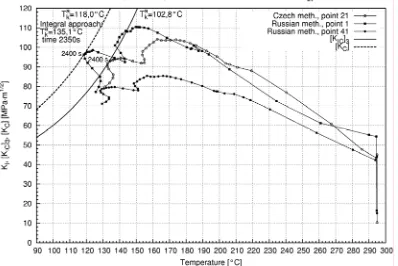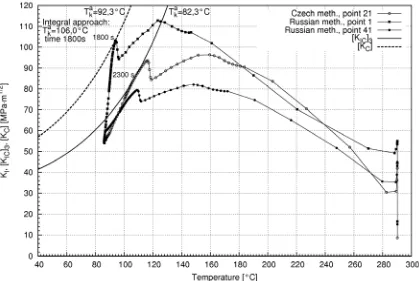18th International Conference on Structural Mechanics in Reactor Technology (SMiRT 18) Beijing, China, August 7-12, 2005 SMiRT18-F05-2
COMPARISON OF “VERLIFE” AND RUSSIAN METHODOLOGIES
FOR REACTOR PRESSURE VESSEL INTEGRITY ASSESSMENT
Vladislav Pistora
Division of Integrity and Technical Engineering
Nuclear Research Institute Rez, plc.
Husinec-Rez 130, 250 68 Rez, Czech Republic
Phone: +420 266 173 220
Fax: +420 220 940 519
E-mail: pis@ujv.cz
Ales Kacor
Division of Integrity and Technical
Engineering
Nuclear Research Institute Rez, plc.
ABSTRACT
Currently used methodology for the assessment of the reactor pressure vessel (RPV) integrity in the Czech Republic is based on the „Unified Procedure for Lifetime Assessment of Components and Piping in WWER NPPs, VERLIFE” developed within the Project of the 5th Framework Programme of the EU by a group of experts from WWER operating countries. This methodology was compared with the recent Russian methodology for the RPV integrity assessment “Methodology of Determination of the Residual Lifetime of the Reactor Pressure Vessels of WWER Reactors During Operation, MRK-SChR-2000”.
Both methodologies are based on the same principle – comparison of stress intensity factor KI with its allowable value. This is evaluated for postulated crack defined according to the methodology. The assessment is performed for a set of emergency events of the pressurised thermal shock (PTS) type. In both methodologies, critical temperature of brittleness Tk was taken as the index temperature on which the assessment is based (but also reference temperature T0 and Master Curve approach can be applied within the VERLIFE methodology).
Series of sensitivity analyses was performed to assess the influence of individual parameters entering the RPV integrity assessment, which are prescribed differently within both methodologies. The parameters were as follows: crack shape, crack depth, residual stresses, curve of allowable values of stress intensity factor (together with crack front length and shallow crack adjustments) and integral vs. point-by-point assessment. The sensitivity studies were performed for large break LOCA transient.
Finally, the assessments of three selected PTS events were performed according to both methodologies and the results were compared. The VERLIFE methodology was found to be more conservative in comparison with the Russian one.
Keywords: reactor pressure vessel, integrity assessment, pressurised thermal shock, methodology
1. INTRODUCTION
Part of this methodology concerning the assessment of the resistance of RPV against fast fracture is based mainly on the IAEA Guidelines (1997). On the other hand the new methodology “MRK-SChR-2000” (2000) has been developed by leading Russian organization in nuclear area. The aim of this paper is to compare both methodologies from qualitative as well as quantitative point of view. Qualitative comparison of the methodologies presents comparison of individual parameters entering the assessment prescribed in both methodologies. Quantitative comparison presents results of sensitivity analyses on the influence of individual parameters entering the RPV integrity assessment and results of some comparative examples.
2. QUALITATIVE COMPARISON OF THE METHODOLOGIES
The qualitative comparison of the methodologies is based on comparison of the main parameters entering the assessment. The main parameters entering the structural part of pressurised thermal shock (PTS) assessment are compared in the following comparative Table 1. The following graphical emphasizing of individual cells within the comparative table is used:
If the parameter is applied equivalently in both methodologies, then the concerned cells remain white. If the parameter is applied in different manners in the methodologies, then the appropriate cell corresponding to the methodology, where this parameter is applied more conservatively, is emphasized by grey colour. The conservativity of the parameter is based on expert judgement.
Table 1 Comparison of main parameters entering the assessment
Parameter VERLIFE Russian methodology Note
Transition temperature
Critical temperature of brittleness Tk or reference temperature T0 according to Master Curve
Critical temperature of brittleness Tk
Fracture mechanics parameter
Stress intensity factor KI As VERLIFE
Postulated crack
Orientation Axial and circumferential As VERLIFE
Shape Semiellipse Ellipse, provided that NDE of cladding is being performed and no flaws in cladding are detected that would exceed allowable sizes of flaws
Based on sensitivity analyses, it may be said that the elliptical crack yields higher values of KI, mainly in points near to cladding/base material interface Location Underclad crack, provided
that both integrity of cladding has been proved by NDE methods and mechanical properties of cladding are known
Underclad crack, provided that the same conditions (concerning NDE of cladding) as above (for crack shape) are fulfilled
VERLIFE deals with performing the qualified NDE of cladding and knowledge of its mechanical properties, while Russian methodology deals only with performing the NDE of cladding (without mentioning the qualification) and its results
Depth a=(SN+S)/10 2a=0,07⋅S The same as above (for location)
a/c ratio 0,3 and 0,7 0,333 Due to elliptical shape the
Russian crack is smaller Fatigue
crack growth
Is not taken into account Is taken into account Fatigue crack growth in cylindrical part of RPV is very low
Parameter VERLIFE Russian methodology Note
Residual stresses
- due to cladding
Residual stresses are included via setting stress free temperature equal to operation temperature
In the cladding 390 MPa approximately.
Under the cladding based on temperature and time of tempering
According to the VERLIFE, the residual stress in cladding (at room temp.) is 200 MPa approximately. Underclad region is not treated separately.
- due to
welding ⎟⎠
⎞ ⎜ ⎝ ⎛ ⋅ = S x π
σ 60 cos 2 [MPa]
(valid both for axial and circumferential stress) Axial stress: ⎟ ⎠ ⎞ ⎜ ⎝ ⎛ ⋅ = S x OM π σ
σ cos 2 ,
circumferential stress:
OM
σ
σ = (constant along wall thickness), σOM
based on temperature and time of tempering
For conditions of Temelin NPP, σOM ∼ 100 MPa when evaluated according to the Russian simplified procedure.
Constant circumferential stress along the wall thickness is conservative.
Allowable value of KI curve
[ ]
KIC 3=26+36⋅exp[
0,02(T−TK)]
KIC =23+48⋅exp[
0,019(T−TK)]
Russian methodology: the curve is relevant to thickness of 150 mm and probability of fracture 5%. VERLIFE: no such specifications. Effect of
shallow crack and biaxiality
Is not taken into account
IC b
C K
K =
ω
⋅ω
⋅ fora<0,15(S+SN)
ω>1 effect of shallow crack 0,9<ωb<1 effect of biaxiality Adjustment
to crack front length Bi
Within Tk approach is not considered
Within T0 approach is considered
[ ]
(K Kmin) KminB B
K C
i
C ⎟⎟ − +
⎠ ⎞ ⎜⎜ ⎝ ⎛ = 4 1
Kmin=20 MPa.m1/2,
B
=150 mmRussian methodology uses similar adjustment as used in Master Curve approach.
Upper limit for KIC
200 MPa.m1/2 As VERLIFE
Safety factor on loading
None 1,1 for KI (primary stresses), 1 for KI (secondary stresses), (KI)i = 1,1⋅KIP + KIS
Russian methodology: the safety factors are applied to individual loads in elasto-plastic calculat. Temperature
safety factor
None As VERLIFE
Warm pre-stressing (WPS) approach
Can be applied Can be applied Both methodologies permit application of WPS approach even in some cases of re-loading
Basic condition of resistance against fast fracture
The following condition
[ ]
IC 3I K
K ≤
must be fulfilled in all points of the crack front
The following condition
[ ]
C iI K
K ) ≤ (
must be fulfilled in all points of the crack front
The Russian methodology allows for “softening” of this condition, see the following item
A more detailed analysis of resistance conditions
Is not considered Instead of comparison of KI-value with [KC] in each point of crack front, the following integral condition
1 1 2 2 4 ≤ − ⎟⎟ ⎠ ⎞ ⎜⎜ ⎝ ⎛ − − ∫ − ϕ ϕ ε ϕ ϕ π π d K K K K B c C i I sin ) ( ) ( ) ( min min is evaluated,
φ – elliptical angle
ε – numerical eccentricity
Integral condition is derived from the probabilistic approach. It is less conservative than evaluation of the condition (KI)i ≤
[ ]
KC in each point of the crack frontComments to the comparative table:
VERLIFE is conservative mainly with respect to the postulated crack size. It prescribes higher depth of the crack and due to semi-elliptical shape and aspect ratio a/c = 0,3, it has also higher maximum length (see Fig. 1). As far as postulated crack size is concerned, the Russian methodology does not take into account performing and results of NDE of the weld or base material, neither it mentions qualification of the NDE method. The postulated crack size is 0,07·S.
As far as postulated crack shape is concerned, the Russian methodology seems to be conservative in comparison to VERLIFE. In particular, higher values of KI are obtained in points near to cladding/base material (or weld) interface. Question, whether size or shape of the postulated crack will dominate in the final assessment, could be answered only after performing the appropriate calculations (see next chapter).
Fig. 1 Postulated cracks according to VERLIFE and Russian methodologies
VERLIFE is conservative with respect to the curve of allowable value of KI. This curve as defined in the
VERLIFE methodology lies “below” the Russian methodology curve (curve without further adjustments), i.e. the VERLIFE curve is conservative (see Fig. 2).
Fig. 2 Dependency of allowable stress intensity factor on (T - T
k)
In the Russian methodology, this curve may be still shifted up due to the effect of shallow crack (for cracks with depths lower than 0,15(S+SN), which is our case). Neither simultaneously applied effect of biaxiality
V03
V07 R
De pe nde nc y o f allo wable s tre s s inte ns ity fac to r o n T - TK
0 20 40 60 80 100 120 140 160 180 200 220
-100 -90 -80 -70 -60 -50 -40 -30 -20 -10 0 10 20 30 40 50 60 70 80 90 100 T - TK [C]
[MP a .m1/2
]
(decreasing the allowable value of KI) can dominate the favourable effect of shallow crack. Russian methodology further increases the allowable values of KI (towards less conservative values) due to adjustment to crack front length (postulated crack front length is lower than specimen thickness 150 mm for which the original Russian material curve has been derived).
Evaluation of condition KI ≤ [KIC]3 in each point of crack front as prescribed in VERLIFE methodology is conservative compared to the integral approach recommended in the Russian methodology.
Russian methodology is conservative mainly in interpretation of residual stresses, since in some cases higher residual stress is prescribed than in the VERLIFE methodology. Further, the Russian methodology is moderately conservative from point of view of safety factor application. This safety factor (for emergency conditions) equals 1.1 and is applied only to primary stresses (loads), therefore it may be expected that its influence will not be significant.
3. QUANTITATIVE COMPARISON OF THE METHODOLOGIES
The quantitative comparison of the methodologies consists of a set of sensitivity analyses and of a set of example transients. The aim of the sensitivity analyses was to evaluate the influence of individual main parameters entering the PTS assessment, which differ in the two methodologies. The examples for 3 selected transients give us the comparison of the assessment performed fully according to the VERLIFE methodology with assessment performed fully according to the Russian methodology.
All necessary FEM calculations were performed by the SYSTUS code for the mesh including crack. Nonlinear heat transfer and elastic-plastic calculations were performed. The stress intensity factors KI were calculated from the energy release rate G directly calculated within the SYSTUS code.
3.1 Sensitivity analyses
Large break LOCA (DN 850 mm) - a PTS type transient - was selected for the sensitivity analyses. The sensitivity analyses started from the “basic case”, which was the analysis performed fully according to the VERLIFE methodology. The parameters of the basic case were as follows:
Postulated crack: circumferential, semielliptical, underclad crack, with a=20 mm, a/c=0,7 (see Fig. 3). Residual stress:
due to cladding: stress free temperature 290 ºC,
due to welding: ⎟
⎠ ⎞ ⎜ ⎝ ⎛ ⋅ =
S x π
σ 60 cos 2 . (1)
Allowable value of KI:
[ ]
KIC 3=26+36⋅exp[
0,02(
T−TK)
]
, (2)no adjustment to constraint (nor shallow crack nor biaxiality), no adjustment to crack size.
Warm pre-stressing approach:
applied on 90% of maximum KI. Assessment condition:
[ ]
IC 3I K
K ≤ (3)
must be fulfilled in all points of the crack front.
The above-mentioned main parameters were individually changed according to the Russian methodology (while the others remain unchanged – according to the VERLIFE methodology) to assess the influence of each main individual parameter on the results.
Finally, the assessment of the selected transient was performed fully according to the Russian methodology. Influence of safety factor (1.1 applied on primary stresses) was not assessed within the sensitivity study due to very small pressure for large LOCA transient. Effect of the fluence attenuation through the RPV wall thickens was not taken into account.
Postulated crack: elliptical, circumferential, underclad, with 2a=20 mm, a/c=0,333 (see Fig 4). The aspect ratio a/c=0,333 was chosen according to the Russian methodology. In this case, the total lengths of both cracks are very close (57,14 mm VERLIFE meth., 60 mm Russian meth.); consequently, the areas of both cracks are also very close. In this case only the influence of the crack shape is assessed.
Remark: the tangent point between the ellipse and the cladding interface is singular and the direct KI evaluation in the vicinity of this point is impossible (it is sensitive on parameter). An extrapolation of correctly calculated KI values from points lying deeper in the wall to the points close to the interface was performed.
Fig. 3 FEM mesh for semiellipt. crack (basic case) Fig. 4 FEM mesh for elliptical crack
The quantitative results are presented by the standard manner on the diagrams of dependency of KI on temperature (see Fig. 5) and by calculation of the maximum allowable critical temperature of brittleness Tka (warm pre-stressing approach was used in this case). Moreover, the diagrams of dependency of KI on the distance from cladding/base mat. interface for points lying on the crack front for a selected time (close to the critical one) are presented in Fig. 6.
Qualitative result:
Elliptical crack produces significantly higher KI values in crack front points close to the cladding/base mat. interface than the semielliptical one. Near the deepest point, the results for both shapes are similar.
Fig. 5 Influence of crack shape (KI dependency on temp.) Fig. 6 KI dependency on distance from cladding
Postulated crack: depth a = 13,5 mm ( ≅ 0.07·(S+SN)), semielliptical, circumferential, underclad, a/c=0,7. Since the aspect ratio is the same as for the basic case, the crack area has decreased compared to the basic case. The critical point is near the interface. The results are presented by the same manner as in the previous case (see Figs. 7, 8).
Qualitative result: The KI values in corresponding points decreased.
Fig. 7 Influence of crack depth (KI dep. on temp.) Fig. 8 KI dep. on distance from cladding
3) The influence of residual stress
Residual plastic strains according to appendices P.V and P.A of the Russian methodology were applied (simplified approach allowed by the methodology). The amplitude of residual plastic strain -0,05 % due to welding was applied (which corresponds to the residual stress 100 MPa) based on Fig. P.A.4 according to temperatures and times of duration of RPV tempering. The amplitude of residual plastic strain -0,15 % due to cladding was applied, based on Fig. P.A.4. Other parameters were the same as in the basic case. The corresponding residual stresses according to the VERLIFE methodology were significantly lower. The results are presented by the diagrams of dependency of KI on temperature (see Fig. 9) and by calculation of the Tka values.
Qualitative result: The KI values increased.
4) The influence of allowable stress intensity factor curve
Within the basic case, the “VERLIFE curve”
[ ]
KIC 3=26+36⋅exp[
0,02(
T−TK)
]
(4) was used and neither adjustment to constraint nor adjustment to crack size was performed.Influence of several options can be assessed:
• Adjustment to constraint – shallow crack effect - according to Appendix P.2. (In our situation no adjustment to biaxiality can be applied due to relatively small KI.)
• Adjustment to crack size according to par. 4.1.6:
[ ]
min min) (K K K B
B
K C
i
C ⎟⎟ − +
⎠ ⎞ ⎜⎜ ⎝ ⎛ =
4 1
(5)
• Russian allowable stress intensity factor curve: KIC =23+48⋅exp
[
0,019(
T−TK)
]
(6)Different combinations of the above-mentioned possibilities were assessed: • VERLIFE curve + adjustment to crack size
• VERLIFE curve + adjustment to shallow crack
• VERLIFE curve + adjustment to shallow crack + adjustment to crack size • Russian curve
• Russian curve + adjustment to crack size • Russian curve + adjustment to shallow crack
• Russian curve + adjustment to shallow crack + adjustment to crack size
The results are presented by the diagram of dependency of KI on temperature (see Fig. 10) and by calculation of the Tka values. Moreover, diagrams of dependency of KIC on temperature are presented for all above-mentioned combinations of options. These diagrams are drawn for Tk equal to Tka for the basic case.
Qualitative result: All modifications lead to less conservative solutions, i.e. applying of the VERLIFE methodology is conservative.
Fig. 10 Influence of allowable stress intensity factor curve (KI and [KIC] depend. on temperature)
Allowable stress intensity factor curves
(for TK=103,7 C, adjustments for base case crack)
0 10 20 30 40 50 60 70 80 90
50 60 70 80 90 100 110 120 130 140 150 160
T [C]
[MPa.m1/2]
Russian curve VERLIFE curve
Russian curve, adjustment to crack size VERLIFE curve, adjustment to crack size
Russian curve, adjustment to shallow crack VERLIFE curve, adjustment to shallow crack
Russian curve, adjustment to shallow crack and to crack size VERLIFE curve, adjustment to shallow crack and to crack size KI (LOCA 850, base case)
4) The influence of integral approach
Within the basic case, the point-by-point fulfilment of the condition KI ≤
[ ]
KIC 3 was checked. For the integral approach the following condition is evaluated:1
1
2 24
≤
−
⎟⎟
⎠
⎞
⎜⎜
⎝
⎛
−
−
∫
−ϕ
ϕ
ε
ϕ
ϕ
π
π
d
K
K
K
K
B
c
C i I
sin
)
(
)
(
)
(
min min
(7)
where
φ is the elliptical angle of the point on the crack front (see Fig. 11),
ε is numerical eccentricity of the ellipse.
The integral approach includes the size adjustment inherently.
The results are presented by calculation of the Tka values and illustrated by the diagrams of dependency of KI and [KIC] on the distance from cladding/base mat. interface for points lying on the crack front for a selected time (close to the critical one), see Fig. 12.
Qualitative result:
Integral approach leads to less conservative solution.
Fig. 11 Elliptical angle
Fig. 12 Influence of integral approach - dependency of K
Iand [K
IC] on distance from
cladding/base interface
a
ϕ
2
c
dB
y
x
ϕ
1Influence of integral approach (LOCA 850, time 1100 s)
0 10 20 30 40 50 60 70 80 90
0 1 2 3 4 5 6 7 8 9 10 11 12 13 14 15 16 17 18 19 20 distance from cladding [mm] [MPa.m1/2] K_IK_IC (size corrected) for tangent approach, T_Ka=113,5 C
The following Table 2 presents the results of all performed sensitivity analyses, i.e. the influence of individual parameters on the resulting maximum KI and Tka. For the basic case (LOCA 850 according to the VERLIFE methodology) the resulting values were as follows:
critical time 1230 s,
maximum KI = 68 MPa⋅m1/2, Tka = 103,7 ºC.
In the Table 2, the differences between the results of individual sensitivity analyses and those of the basic case are presented. Results for those parameters, which give more conservative solution in comparison to the basic case, are written in red while the others are written in green.
Table 2 Results of sensitivity analyses.
Parameter Difference in max
KI [MPa⋅m1/2]
Difference in Tk a
[ºC]
Crack Shape (ellipse) +34 -42
Depth (13.5 mm) -13 +18
Residual stresses
+15 -21
VERLIFE curve, adjusted to crack size x +10
VERLIFE curve, adjusted to shallow crack x +10
KIC curve VERLIFE curve, adjusted to shallow crack and crack size
x +19
Russian curve x +11
Russian curve, adjusted to crack size x +20
Russian curve, adjusted to shallow crack x +19
Russian curve, adjusted to shallow crack and crack size
x +27
Approach Integral approach (compared for size corrected KIC curve)
x +13
All together Full Russian methodology without integral approach
+23 -11
Full Russian methodology with integral approach
+23 +13
We can see that (similarly to the results of qualitative analyses presented in the Table 1) the Russian methodology is conservative only in crack shape and residual stresses.
3.2 Examples
Comparison of the assessment performed fully according to the VERLIFE methodology with the assessment performed fully according to the Russian methodology was performed for 3 selected transients:
• LOCA DN 850 mm (guillotine break of hot leg of main circulating pipe) • Simultaneous break of 2 steam lines outside the containment
The results are presented in Figs. 13 – 15 by the diagrams of dependency of KI on temperature and by calculation of the maximum allowable critical temperature of brittleness Tka. The warm pre-stressing approach was used in the first example while the tangent approach had to be used in the two others examples due to reloading.
Fig. 13 Example of comparison of VERLIFE and Russian methodologies - LOCA DN 850 mm
Fig. 15 Example of comparison of VERLIFE and Russian methodologies – Inadvertent
opening of pressurizer safety valve with its reclosure
The resulting maximum allowable critical temperatures of brittleness Tka calculated according to both methodologies for all three examples are presented in the Table 3. The more conservative results according to the Russian methodology in comparison to VERLIFE are written in red while the less conservative results are written in green.
Tab. 3 Results of examples - Tk a
calculated according to VERLIFE and Russian methodologies
For all 3 analysed examples is the Russian methodology with application of the integral approach less conservative than the VERLIFE methodology. For the last two examples this is true even without application of the integral approach.
PTS
VERLIFE
Russian methodology
without integral
approach
using integral
approach
T
ka[ºC]
T
ka[ºC]
T
ka[ºC]
Large LOCA
(H850)
103,7
92,2
117,0
Steam line break
(2SLB)
102,8
118,0
135,1
PRZ SV opening
(pvko43b)
82,3
92,3
106,0
PTS
VERLIFE
Russian methodology
without integral
approach
using integral
approach
T
ka[ºC]
T
ka[ºC]
T
ka[ºC]
Large LOCA
(H850)
103,7
92,2
117,0
Steam line break
(2SLB)
102,8
118,0
135,1
PRZ SV opening
(pvko43b)
4. CONCLUSION
Based on the qualitative and quantitative comparison, we can state that the VERLIFE methodology for the integrity assessment of the reactor pressure vessel is more conservative in comparison with the recent Russian one.
REFERENCES
Guidelines on Pressurized Thermal Shock Analysis for WWER Nuclear Power Plants, (1997), IAEA-EBP-WWER-08, IAEA, Vienna
Methodology of Determination of the Residual Lifetime of the Reactor Pressure Vessels of WWER Reactors During Operation, (2000), MRK-SChR-2000, St. Petersburg-Moscow, (in Russian)
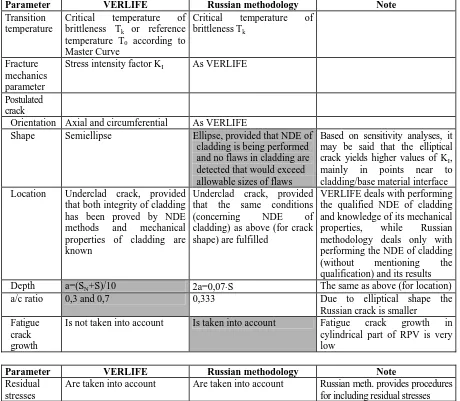
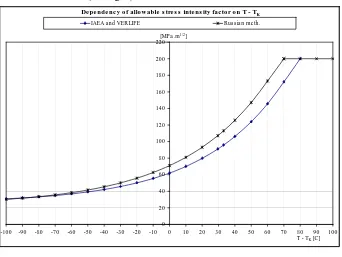
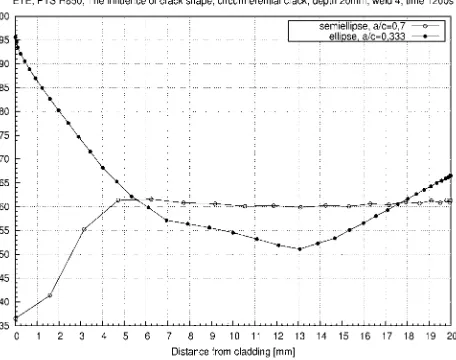
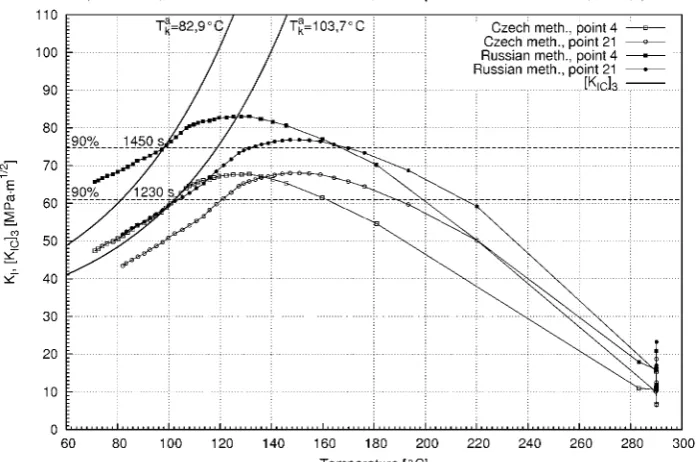
![Fig. 10 Influence of allowable stress intensity factor curve (KI and [KIC] depend. on temperature)](https://thumb-us.123doks.com/thumbv2/123dok_us/1287549.1161288/8.595.66.533.404.724/influence-allowable-stress-intensity-factor-curve-depend-temperature.webp)
![Fig. 12 Influence of integral approach - dependency of KI and [KIC] on distance from cladding/base interface](https://thumb-us.123doks.com/thumbv2/123dok_us/1287549.1161288/9.595.123.476.303.728/fig-influence-integral-approach-dependency-distance-cladding-interface.webp)
